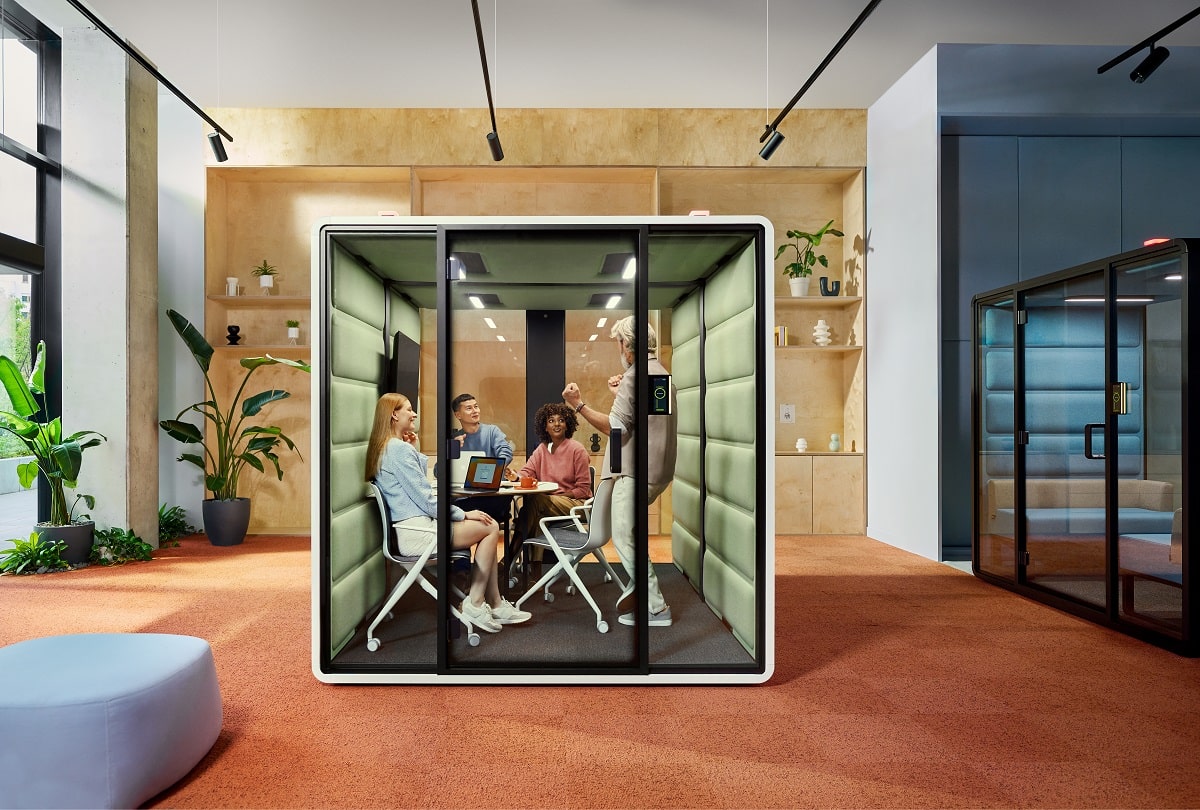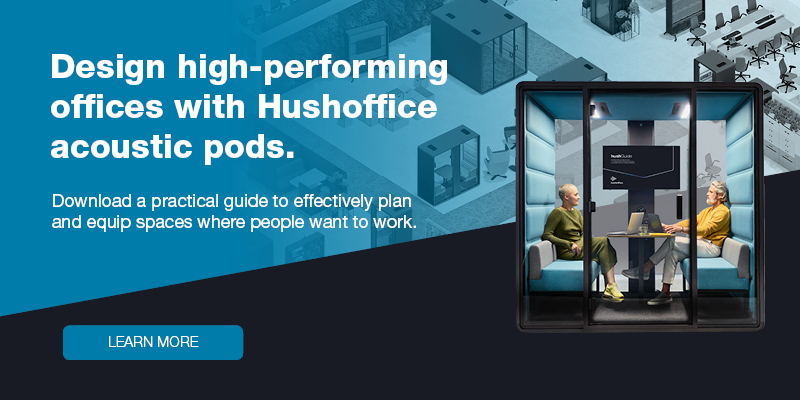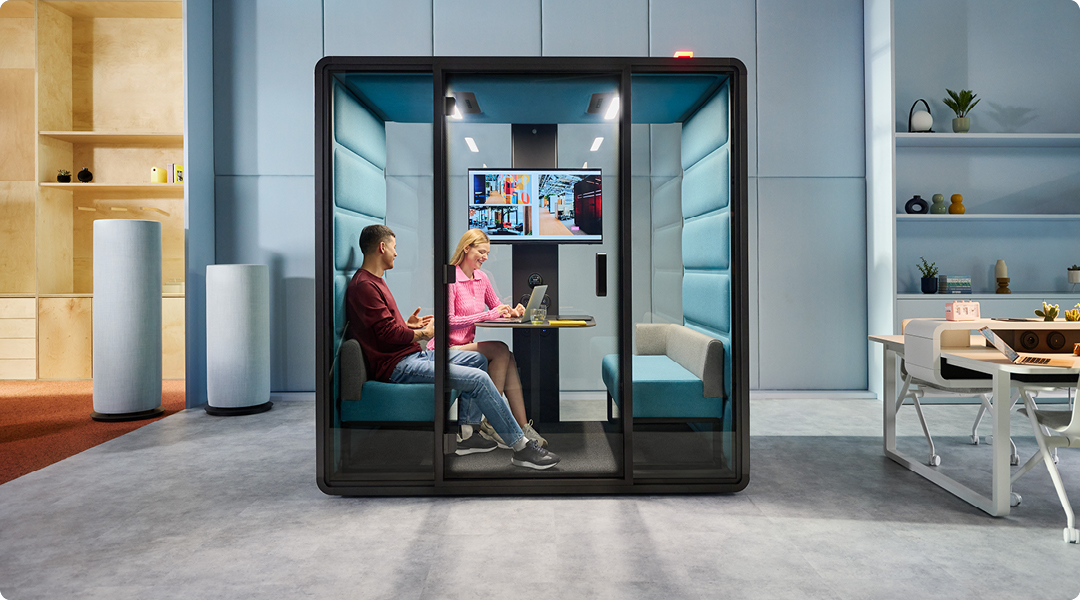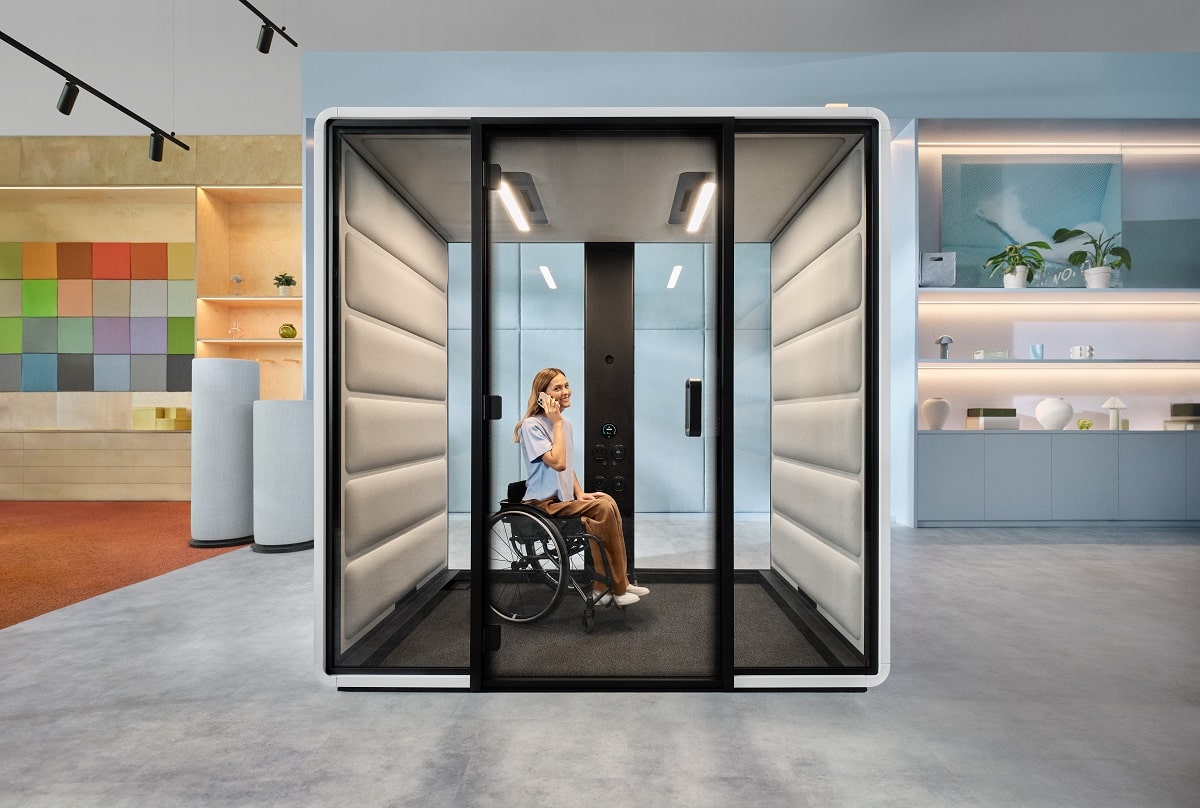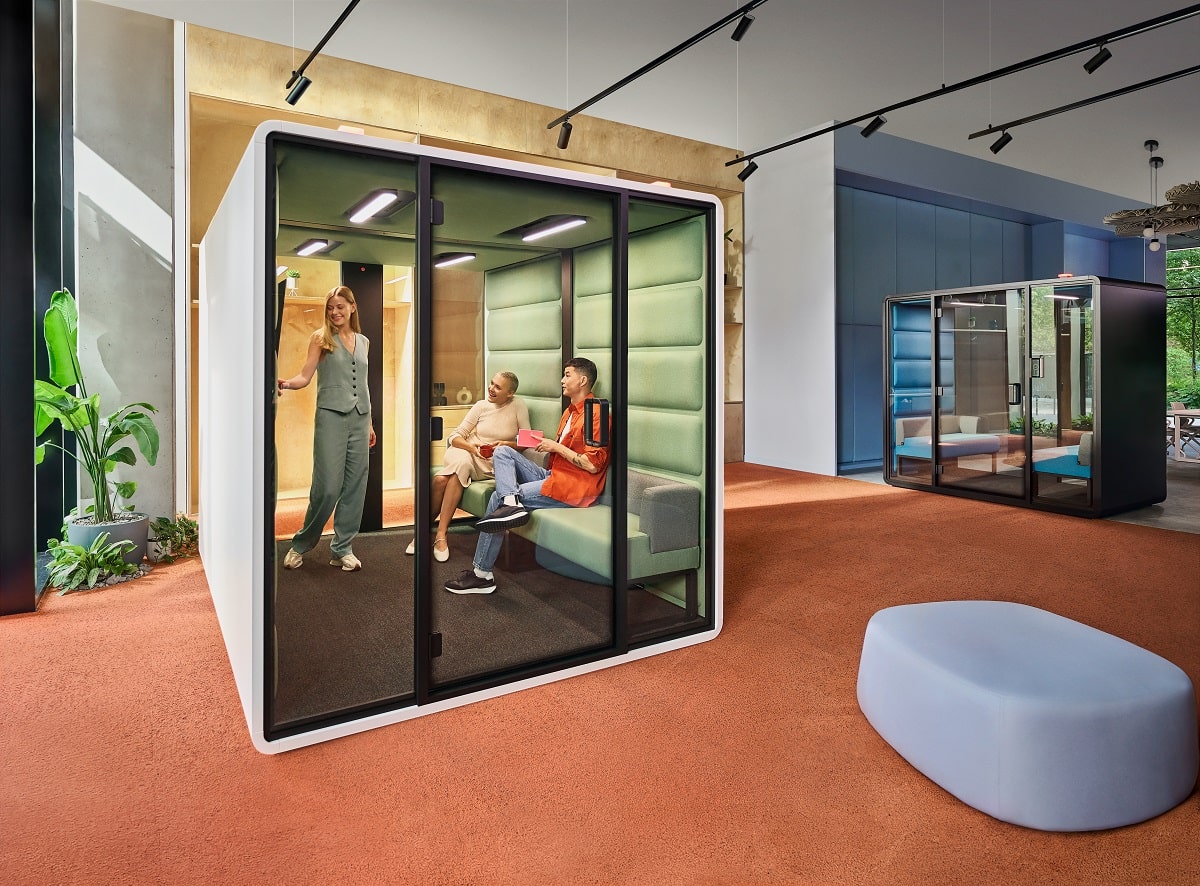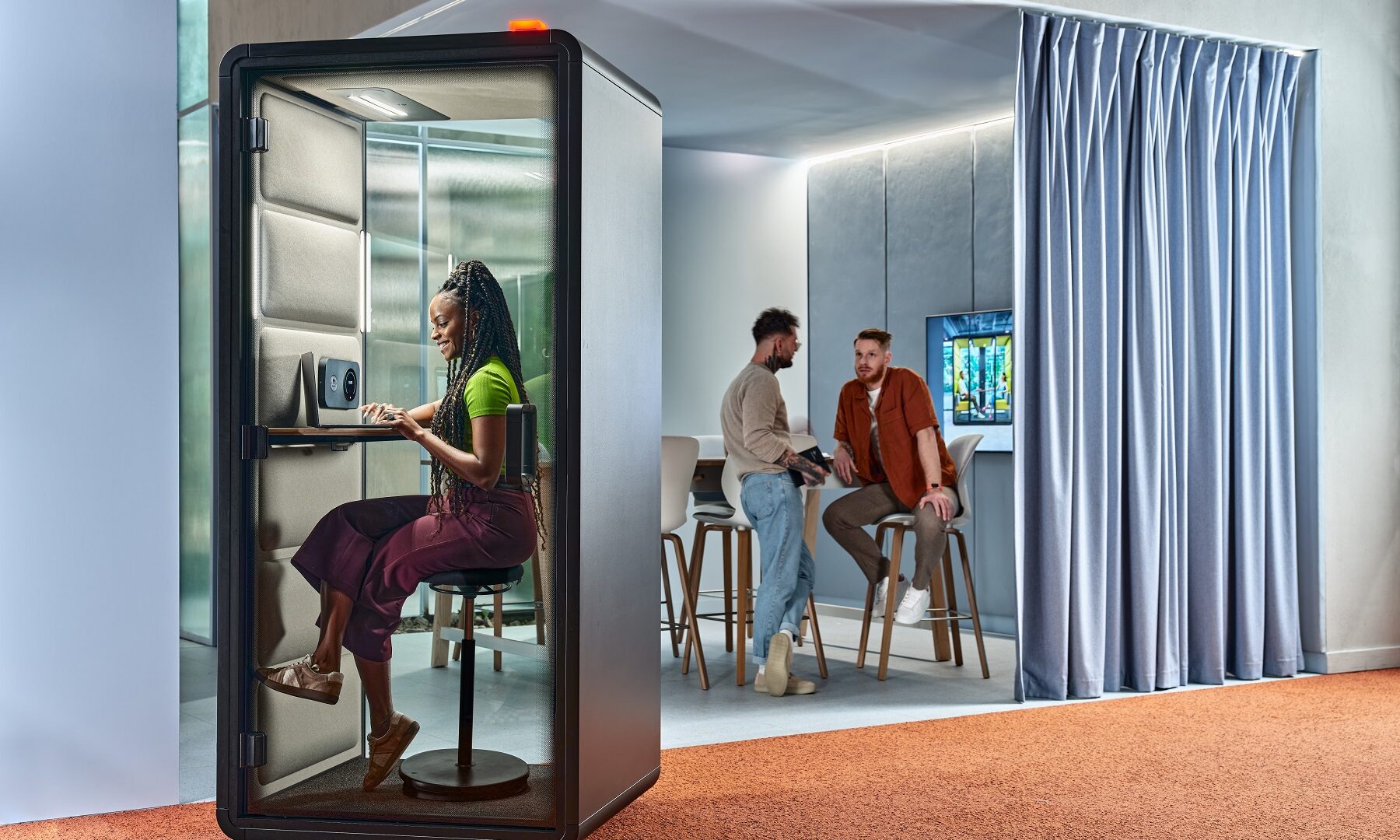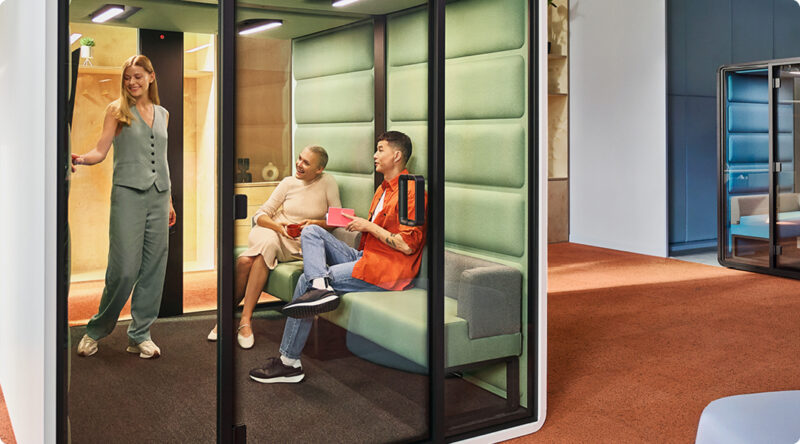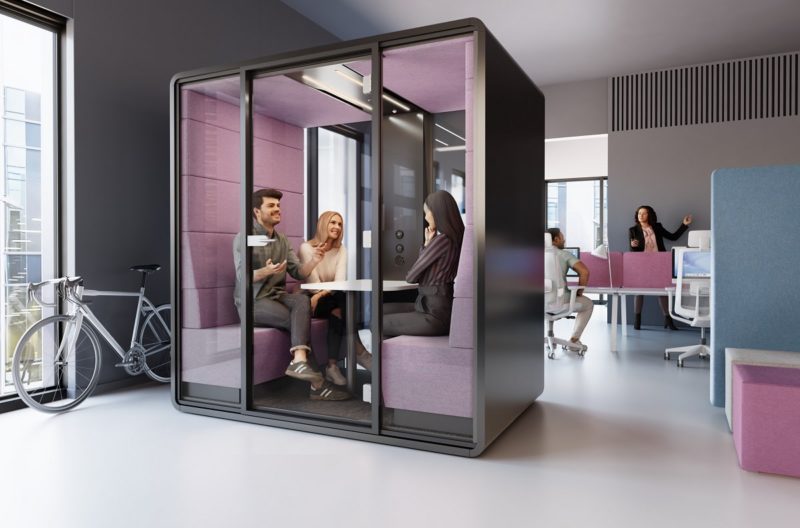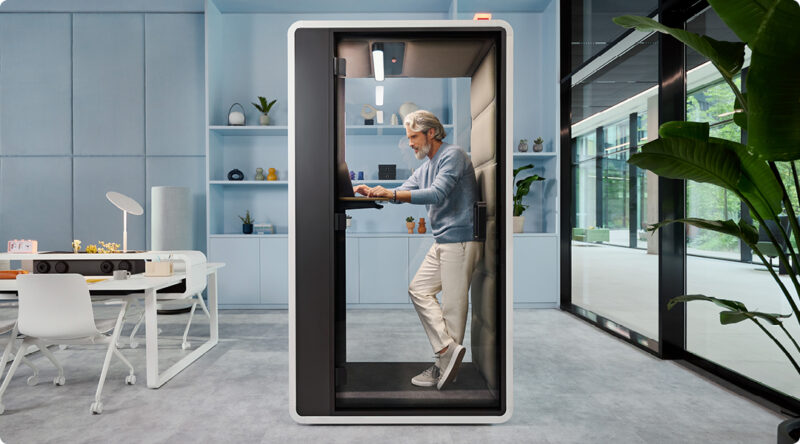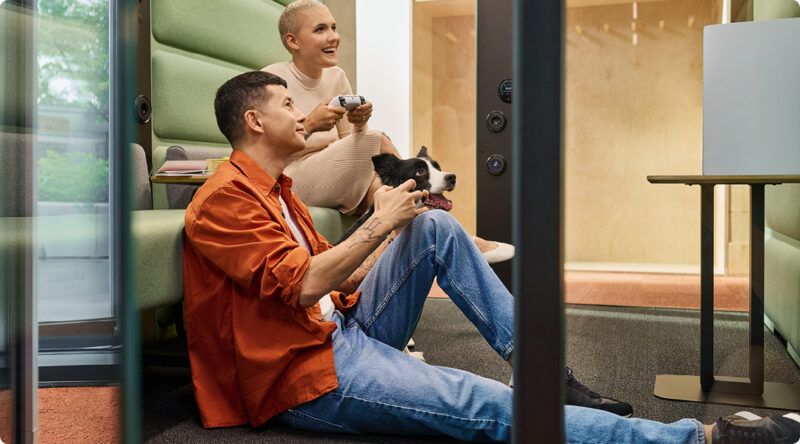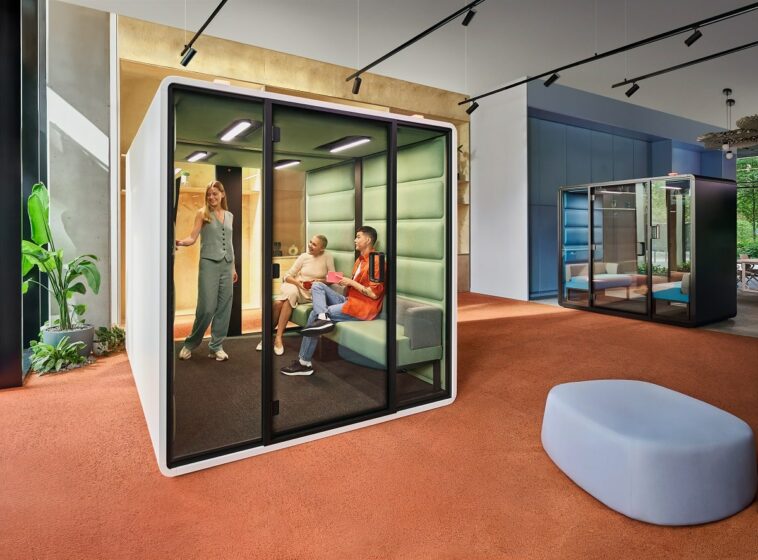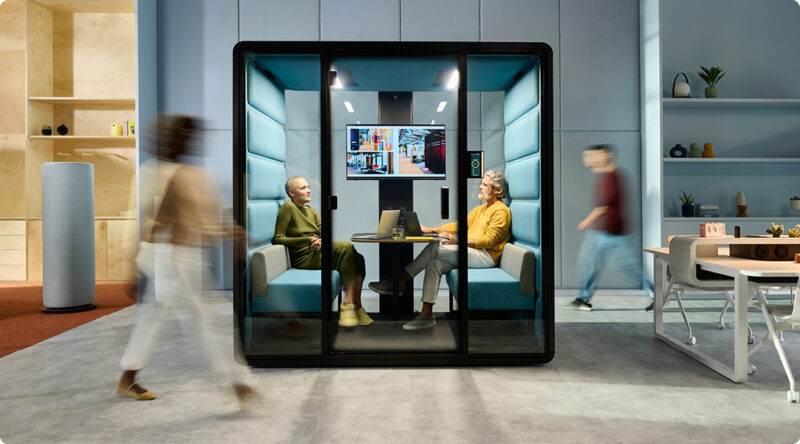Sensory-aware office design is the way to better teamwork
- Posted on: 1 July 2025
- By: Hushoffice Team
An office’s energy is rooted in the acute sensory details. How one space sounds. How another feels. How the broad floor looks. These details guide how people interact and create. And by offering sensory-friendly booths like Hushoffice, you set the stage for easy collaboration.
Designing the office for teamwork – tl;dr
- Sensory cues regulate brain states tied to attention and emotional safety, making sensory-aware design essential for trust and collaboration. Indeed, when the senses feel secure and balanced, teams connect more deeply and openly.
- Acoustic privacy is a crucial parameter. It reduces cognitive overload and stress. It creates a calm space for clear and honest dialogue. Its quiet foundation helps teams build the camaraderie needed to work together well.
- Mobile booths like hushFree are excellent sensory-balanced workspaces. They give people control over their environment including lighting, sound, ventilation, and visual distractions. The autonomy they promote is focus enhancing, but it is also a morale boost, making people friendlier and more team-minded.
Office atmosphere is a team’s creativity and cohesion.
The office can nudge people into more attentive and imaginative states simply by how it sounds, looks, and feels. And at the end of the day, its atmosphere — that “feeling” it engenders through senses, through sights and sounds — and a team’s effectiveness are but one and the same.
Because team synergy starts with trust (which is deeply influenced by space).
Every spot in the office should either help people connect on a human level or disconnect in a way that is recharging such as with a private work booth. When a workplace makes it easy to hear one another clearly, see one another’s faces, and give others your full attention, trust comes naturally.
The office’s layout shapes human interaction in many ways…
At the end of the day, every design choice — how desks are arranged, where private spaces are located, how movement flows through the space — either brings people together or pushes them apart.
Open walkways encourage ad hoc conversations…
When paths are wide and lead past shared areas like coffee points or collaboration huddles, people bump into each other. Their chance encounters can spark new synergies or, as importantly, build up working relationships.
Overexposed desks make people feel on display…
If workstations face high-traffic areas or lack visual or acoustic separation, employees may feel watched. This will certainly lead to self-consciousness, weakening communication. In the worst case, even whispering or laughing begins to feel awkward in this scenario.
Lack of seclusive spaces stunts honest dialogue…
Without dedicated spots for sensitive conversations, employees may postpone the tough talks. People may even inadvertently avoid the important one-on-ones altogether. Everyone needs low-stimulus areas like booths where they can speak openly without being overheard.
Clustered seating can boost collaboration (or create noise fatigue)…
Seating teams near each other can speed up communication. But if the area isn’t acoustically managed, constant chatter will be a problem. Any such layout should include sound-absorbing surfaces or nearby quiet pods for balance.
Corners, alcoves, and soft dividers help introverts engage…
Not everyone is comfortable in wide-open rooms. Offering tucked-away spaces gives the more reserved teammates room to think and the confidence to contribute.
Without private retreats, open space muddies the very communication it catalyzes.
In a busy space, the brain must work harder to filter distractions. This leads to what cognitive psychologists call “attention residue” or the lingering mental load from interruptions. As focus is weakened, the clarity of every conversation diminishes, and teams lose momentum.
- Constant background noise triggers the brain’s stress response, elevating cortisol levels and activating the amygdala, which governs fear and vigilance. In this heightened state, the brain allocates resources toward self-preservation rather than openness or connection. Naturally, this makes trust more difficult to build.
Research in environmental psychology conclusively shows that noise and poor acoustics harms social interactions in a workplace. When a room is loud or echoey, people start to withdraw as a means of coping. Withdrawing is simply about survival. It becomes harder to speak up, harder to listen, and easier to misread one another. We know that purpose-built spaces like team meeting pods are so valuable here because they are calm and fully private. They are an utterly peaceful setting where people can hear each other out and do quality work together
– says Mateusz Barczyk, Senior Brand Manager, Hushoffice.
Sensory overload degrades social exchange.
As people speak more softly to avoid being overheard or interrupting others, miscommunication or avoidance happens. Others may withhold thoughts that require nuance or vulnerability, especially when there’s no space for a private sidebar or emotionally sensitive dialogue.
Zoning the office is one of the best ways to harmonize its many interactions.
And when it comes to dividing up space into a selection of meeting areas, work islands, and relaxed hubs, mobile booths are an especially powerful solution because they are zones unto themselves. They are complete, self-contained environments that require no construction or extra outfitting.
Booths like Hushoffice are a terrific zoning solution. They are prefabricated, fully built out, and instantly usable once placed. Each booth offers a pristine level of acoustic privacy, along with adjustable lighting and ventilation via hushAssistant. They give people control over their sensory surroundings. And because they’re mobile, they can be relocated to support new needs. They maintain the same refuge of single-minded focus wherever they’re placed. For private work, consider a 1-person pod like hushFree.S.Hybrid for its Class A acoustic rating and seated furniture arrangement
– says Mateusz Barczyk, Senior Brand Manager, Hushoffice.
Lighting sets the tone, defining our mental capacity in a workspace.
Studies in chronobiology and neuroscience consistently show that lighting either enhances or impairs cognition, emotional regulation, and, in turn, teamwork. Using tunable lighting that mimics natural changes throughout the day helps align our internal state with the task at hand.
Preferences regarding workspace lighting are highly individual.
Some prefer a bright, cool tone, others something softer and warmer. This reality underscores another reason pods are so effective. In a pod, the employee can tweak lighting to their preference. And in hushFree pods specifically, hushAssistant makes these tweaks intuitive by touch.
A great team space invites openness.
It allows everyone to stay present in the conversation. It’s quiet enough to think clearly and intimate enough to connect. Ultimately, simple, human features like gentle acoustics and natural lighting do more to enable collaboration than any high-end tech.
Flexibility and variety are key parameters for a teamwork-rich office.
A good workplace is a menu of sub spaces and settings. Open tables, classic meeting rooms, enclosed booths like hushFree.M for relaxed team meet-ups. Such spatial diversity supports the principle of stimulus control, which suggests that our environment shapes our behavior by cueing specific mental states.
Furniture arrangements matter, too.
While circular or square tables invite equality and conversation, long rectangular tables can feel more hierarchical. Always, modularity and adjustability are ideal. And with a spacious booth like hushFree.L, you can furnish your go-to meeting space exactly how you need it.
Thoughtful furniture changes can have a massive impact without adding square footage.
Redesigning a meeting room can boost utilization by an incredible 246%. Roomy pods like hushFree.L, ordered unfurnished, work best as they can be furnished for the moment’s needs. And such a mobile pod gives you the ideal space where it’s actually needed, not tethered to building layout.
Acoustics are a meeting’s music, good or bad.
If people are straining to hear or being distracted by outside noise, conversation suffers. Booths like Hushoffice offer a controlled, sound-isolated environment where voices carry clearly and no effort is wasted. They are an ideal setting for everything from one-on-ones to hybrid calls.
Meeting acoustics rely on both absorption and strategic placement.
Only a balanced blend of reflective and absorptive surfaces clarifies speech, ultimately making meetings more productive. Every hushFree booth was meticulously designed to achieve this balance, with fabric-upholstered sound-insulating panels and select materials for a distinct quietude.
Designing for connection means anticipating people’s real needs to eliminate friction.
Every team has different rhythms. The best offices cater to these unique rhythms by making it easy to choose the right workspace without thinking twice.
HushFree booths are mobile, unlocking a modular layout.
Sales teams may need quick huddle zones. Creative teams need space to pin up ideas and iterate. HR might need a quiet pod nearby during performance review season. Product teams may benefit from a movable call pod positioned closer to engineering during launch weeks. Booths work for everyone.
Booths work brilliantly because they are mobile. This means teams can respond to changing dynamics in real time, whether that entails moving a booth closer to a department during crunch time or creating a hushed refuge in a suddenly noisy area. It’s not just about reconfiguring the floor plan but reducing the friction of change itself. And unlike built-in rooms, they don’t become obsolete when priorities switch-up but instead move with people, quietly supporting their real office life
– says Mateusz Barczyk, Senior Brand Manager, Hushoffice.
Acoustic booths for people with disabilities — an accessible, inclusive office.
HushFree.Access.L and hushFree.Access.M (its smaller version) are wheelchair-friendly, easy to enter, and comfortable for all users, including those who are neurodivergent. Their soundproofing helps people with sensory sensitivities feel safe and focused while catering to the universal need for periodic isolation.
Can technology facilitate connection rather than disconnect?
Tech must ease cognitive load rather than increase it. Systems like hushAssistant shine — with one simple touch, you can adjust a hushFree booth’s lights and airflow, dialing in comfort instantly.
How to adapt a meeting space to the needs of people with disabilities?
An accessible space considers every element from barrier-free pathways to doorway thresholds, turning radius, reach range, and sensory elements like lighting and acoustics. For wheelchair-friendliess and premium environmental comfort, consider hushFree.Access.M or the larger hushFree.Access.L.
Peace-and-quiet is a good starting point for universal design.
Our ability to navigate and feel at ease in any space is mediated through the senses. Lighting, sound, texture all give the brain critical information. And when these cues are overwhelming or inconsistent or all but absent, significant barriers are created. It’s important to note that any barrier to using a space intuitively will affect neurotypical employees, too. But for individuals with unique cases like sensory sensitivities, visual impairments, hearing loss, or different processing styles, the irritating elements like glare, echo, visual clutter, and other chaos can make a space altogether unusable
– says Mateusz Barczyk, Senior Brand Manager, Hushoffice.
Designing or retrofitting a workplace for sensory accessibility promises that everyone can participate confidently. And among all these factors, acoustic quiet is one of the most powerful supports. Focus will always come more easily in the lower-stress settings. And from focus comes teamwork.
Investment in your office’s meeting spaces are investments in employees.
Spaces that are made for clear and flowing correspondence help build a sense of belonging. And with meeting booths, the investment pays off in organizational agility — as every booth is mobile, making the layout more easily adjusted. More immediately, every booth pays off in better meetings, too.
Office design for teamwork – tl;dr
- Sensory cues regulate brain states tied to attention and emotional safety, making sensory-aware design essential for trust and collaboration. Indeed, when the senses feel secure and balanced, teams connect more deeply and openly.
- Acoustic privacy is a crucial parameter. It reduces cognitive overload and stress. It creates a calm space for clear and honest dialogue. Its quiet foundation helps teams build the camaraderie needed to work together well.
- Mobile booths like hushFree are excellent sensory-balanced workspaces. They give people control over their environment including lighting, sound, ventilation, and visual distractions. The autonomy they promote is focus enhancing, but it is also a morale boost, making people friendlier and more team-minded.
Office design for teamwork – frequently asked questions
Why is sensory-aware design important for team collaboration?
Sensory-aware design shapes how our brains process the environment. It directly influences focus, emotional comfort, and openness. When an office balances sensory inputs — like sound, light, and layout — teams can communicate more easily. They enjoy trust and innovate more readily.
What is sensory-aware office design?
Sensory-aware office design pays attention to how things like light, sound, and space affect our senses and how we feel. It aims to create a comfortable environment that helps people focus, feel calm, and work well together. This kind of design makes the office easier and nicer for everyone to use.
What are the best office booths for teamwork?
They are spacious, soundproof, and flexible. They should offer enough room for group discussions and provide excellent acoustics so everyone can hear clearly without distractions. Class A acoustic ratings are ideal. Check out Hushoffice pods for inspiration.
